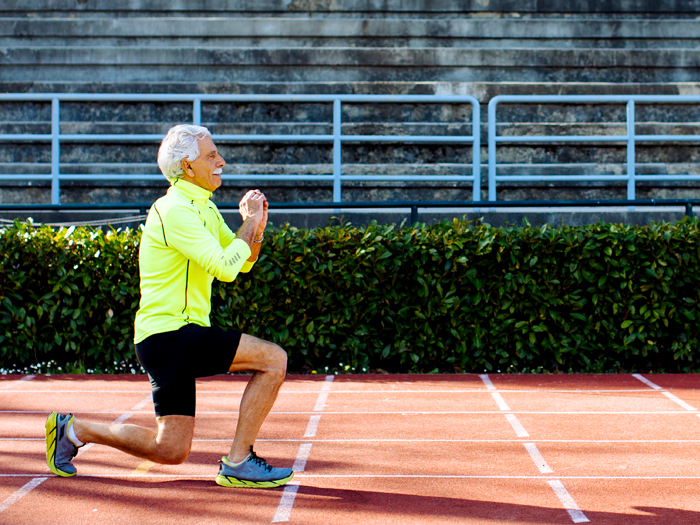4 Ways to Love Lunges Again
Reap the many benefits of this classic strength move without stressing your knees.

Most people have a love-hate relationship with lunges. The love stems from the exercise’s undeniable benefits.
“Lunges and lunge variations build amazing lower-body strength and stability,” says Baltimore-based strength and conditioning specialist Erica Suter, C.S.C.S. “In addition to strengthening the glutes and quads, which are some of the largest muscle groups in the entire body, by requiring a split stance, lunges improve stability at the hips, knees, and ankles.”
They also improve core strength, adds Nick Tumminello, C.P.T., owner of Performance University. All of those benefits translate to better balance and stability and a lower risk of falls, he says.
But there’s still one big reason to hate lunges: knee pain.
“Most people perform lunges with a knee-dominant technique,” Tumminello explains, meaning the body’s weight is distributed so that the knee is doing the majority of the work. If you have knee osteoarthritis, a history of knee injury, or just generally cranky knees, of course they’re not going to be happy with lunges.
The solution is not to grin and bear it! Exercising through joint pain rarely, if ever, ends well. If you have a chronic condition, balance issues, or injuries, start by talking to your doctor about how you can exercise safely.
Then, try the expert-recommended modifications below to see what works best for your body. Once you find a pain-free option, you can look forward to a strong, stable future for your entire lower body.
Lunge Modification #1: Don’t Lower as Far
This should be an obvious fix, but exercisers—especially stubborn ones—tend to dismiss it, Suter says.
Lowering just a few inches into a lunge—rather than all the way until your front thigh is parallel to the floor—is not cheating. If it allows you to perform lunges without pain, it’s a great option, she says.
Always focus on working through a pain-free range of motion. Over time, you may find that increased strength makes it easier to progress farther into each lunge. Or it might not—which doesn’t mean you’re weak.
“Various factors, including hip structure, affect how far someone is able to lower,” Tumminello explains. And you aren’t going to change the shape of your bones.
Lunge Modification #2: Keep Your Feet Planted
Forward lunges, which require you to step forward with each rep, have become the go-to version of this exercise—but not for any great reason. In fact, it can aggravate the knees. Think about it: Each rep involves stepping forward and essentially falling onto your front leg.
You can make lunges an effective, low-impact exercise by keeping both feet on the floor throughout the entire movement. Instead of stepping forward and backward with each rep, simply lower and raise your body while maintaining a solid split stance. Check out more tips for the stationary lunge.
If that’s still too challenging, skip the lowering and raising movements completely. Here’s how: With one foot forward and one foot back, bend your front knee to lower your body into a lunge. Keep your back leg as straight as possible, and come up onto the ball of your back foot. Place your hands on your hips, and take three to five slow, deep breaths as you hold this position. Switch sides, and repeat. See more tips with our beginner’s guide to the lunge.
Lunge Modification #3: Widen Your Stance
You’ve probably heard that you should never let your front knee go past your toes in a lunge, but there’s a better cue to get the same form-fixing outcome: Start your lunges with your back foot farther away from your front foot than you normally would.
You’ll automatically find that you aren’t getting bunched up and compromising your form. And even if your front knee does move past your toes, it will feel far more comfortable, Tumminello says.
Subscribe to our newsletter
It's quick and easy. You could be one of the 13 million people who are eligible.
Already a member? Click to discover our 15,000+ participating locations.
Follow Us
Finding your ideal setup might require some trial and error. Perform a few reps, and if you still feel pain or discomfort in your knee, step your back foot a little father behind you. Keep inching it farther back until you feel the weight on your front knee lessen.
Don’t get too caught up in the exact placement of your knee. Not feeling pressure is more important than making sure your knee stays behind your toes.
Lunge Modification #4: Lean Forward Slightly
Here’s a fun experiment: Perform a few lunges with a stick-straight torso, your head and shoulders directly above your hips. Now, keeping a neutral spine, hinge forward at the hips so that your armpits are directly over your front foot. Perform a few more reps maintaining this torso positioning.
Chances are, you felt a lot less stress—and maybe fewer clicks—in your front knee on the second round, Tumminello says.
That’s because the forward-leaning posture with a relaxed, neutral spine shifts the distribution of weight. Your glutes, which are naturally stronger than your quads, are tasked with doing some extra work.
This allows your quads, which attach to your knees, to not have to work so hard. You’re still engaging and strengthening your quads, but you’ll be easier on your knees.
Take Your Favorite SilverSneakers Classes Online!
SilverSneakers members can access live fitness classes and wellness workshops through SilverSneakers LIVE. See the latest schedule and RSVP for classes here.
Not a member? If you have a Medicare Plan, it may include SilverSneakers—at no additional cost. Check your eligibility instantly here.





